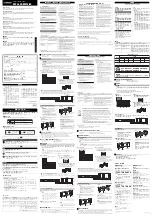
Parker Hannifin
If you do not make any changes to the Memory defaults, the wizard
allocates additional memory to programs zero and one. In addition,
the wizard allocates memory to program 15, which stores wizard
data.
REM-----Allocate system memory-----
DIM PROG0(8192)
DIM PROG1(4096)
DIM PROG2(1000)
DIM PROG3(1000)
DIM PROG4(1000)
DIM PROG5(1000)
DIM PROG6(1000)
DIM PROG7(1000)
DIM PROG8(1000)
DIM PROG9(1000)
DIM PROG10(1000)
DIM PROG11(1000)
DIM PROG12(1000)
DIM PROG13(1000)
DIM PROG14(1000)
DIM PROG15(28672)
REM Some Global Memory is used by Wizard Generated Code
REM P0000 - P0099 Available for User programs
REM P0100 - P0200 Reserved for Software Limits Code
REM P0201 - P4095 Available for User programs
DIM P(100)
DIM DEF(20)
The Configuration Wizard, again, generates default configuration
information. The wizard explicitly sets the ADC mode—the ACR9000
is a 16-bit card and cannot operate otherwise. The next section is
specific to the ACR9000 and does not apply to other ACR
Controllers. Though the controller in this example does not have
CANopen, the wizard generates the set up for CANopen.
When writing your own configuration files, the
ADC MODE
statement
is not required for the ACR9000. Likewise, if the controller does not
have the CANopen feature, the CANopen setup is not required.
REM -- Hardware Configuration
REM 0 = 12 bit card present, 1 = 16 bit card present
ADC MODE 1
REM CANopen Settings
P32768=5
P32769=125
P32772=50
P32770=0
Then begins axis-specific configuration. The axis feedback and
signal output information comes from the Axis and Feedback
dialogs. The PPU (pulses per programming unit) is computed from
data provided through the Feedback and Scaling dialogs. The
excess error band data comes from the Fault dialogs.
ATTACH AXIS0 ENC0 DAC0 ENC0
AXIS0 PPU 39999.999404
AXIS0 EXC (0.2,-0.2)
42 Programmer’s Guide
















































